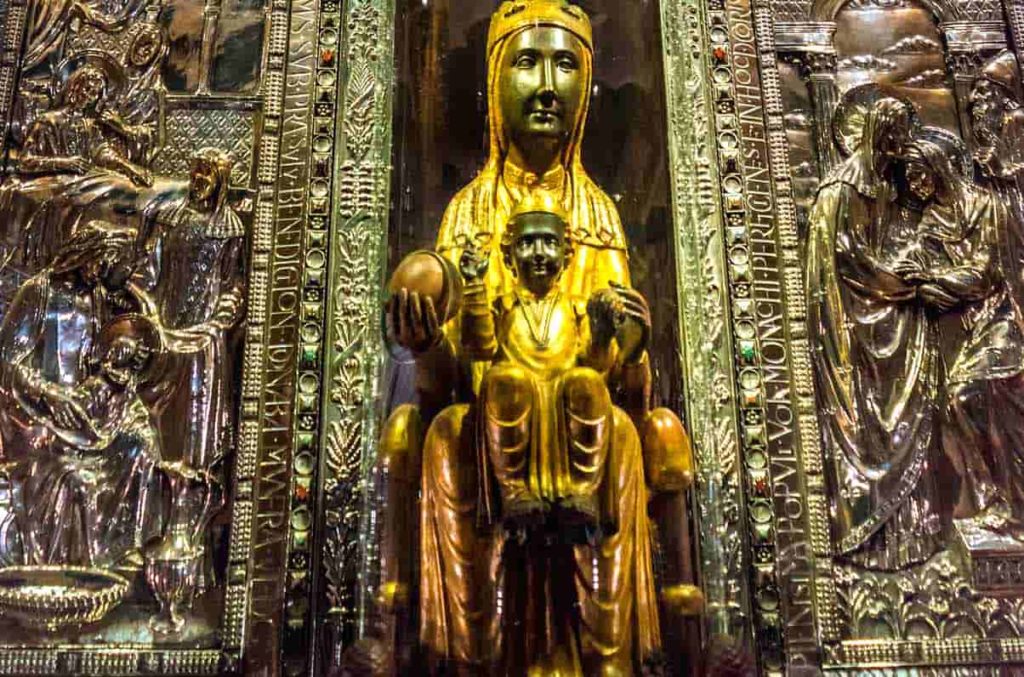The Black Madonna in Montserrat, known as ‘La Moreneta,’ is the patron saint of Catalonia. Her imposing nearly 100 cm height is accentuated by her golden robes as she sits on a grand throne with the Child seated upon her. Both wear striking crowns, painted in the same color, contrasting with their dark skin.
Similarly, the Child resting in her lap holds a pinecone in his left hand while blessing with a gesture from his right hand, symbolizing the Holy Trinity. Meanwhile, the Virgin raises a sphere with her right hand while gently cradling her child, expressing love with her left hand.
Over the years, the grace and spirit of this image have moved and impacted thousands of followers. But what lies behind its miraculous history? Why is Our Lady of Montserrat black? How does her slender black figure differ from conventional depictions of other Virgins?

The secret of Our Lady of Montserrat revealed
For some years, the belief was that the Virgin of Montserrat was not originally black but had been replaced by a black-colored carving during the 12th century. Likewise, her believers and followers even questioned whether the image was truly made of wood.
In 1995, an exhibition catalog dedicated to La Moreneta, titled “Nigra sum,” revealed that the original carving was white and indeed made of wood.
Subsequently, in 2001, the Benedictine abbey conducted studies that confirmed the Virgin of Montserrat’s authenticity. She was carved from poplar wood during the Romanesque period, and initially, the faces and hands of the figures were of a lighter color.
Another investigation took place in Sant Cugat del Vallès, aiming to determine the Virgin of Montserrat’s true age and conservation status, as well as implementing specific preservation methods.
Through various samples and images, these studies concluded that if La Moreneta were not black, her followers would not recognize her.
How did she become the Black Virgin?
According to the studies mentioned earlier, the paint on the faces and hands of the Virgin and the Child contains a significant amount of lead, which has caused their appearance to change over the years due to this element.
Additionally, beliefs suggest that this phenomenon occurred because of the candles and votive offerings lit by pilgrims. With so many people, the skin on their hands, neck, and face gradually darkened. Eventually, the image was repainted in a chestnut color between the 18th and 19th centuries.
All these legends and investigations clearly demonstrate that the black Virgin of Montserrat’s appearance is not accidental but rather the result of changes over time
Detailed description of the Virgin of Montserrat
Some theories about its history indicate that it was carved in Jerusalem, although this fact has not yet been proven.
Except for the dark faces, necks and hands of the Virgin and Child, the rest of the image is completely golden. In this sense, La Moreneta is the popular name of the Virgin due to her black skin.
Like others, the black virgin has been associated with or included in the group of black virgins, which spread to various places in Europe during the Romanesque era, and whose image gave rise to multiple studies throughout the ages. years.
Today, the 95 centimeters high image that we can see is the result of painting, varnishing and repainting that occurred several years ago, mostly in the 12th century. On the other hand, the hands that we can see today of the Child and the Virgin are not the originals, but were modified during the 19th century.
Our Lady of Montserrat and other black Virgins
En España, la Moreneta ha sido la primera Virgen en recibir su coronación canónica, en el año 1881.
However, there are also other brown Virgins in several Spanish cities, such as the Virgin of Guadalupe, in Cáceres, the Virgin of Candelaria, in Tenerife, the Virgin of Water, in Granada, the Virgin of the Virtues, in Alicante, the Virgen de la Cabeza, from the town of Jaén, the Virgin of Torreciudad, the Virgin of la Velía, in Asturias, the Virgin of Argeme, in Coria, the Virgin of the Castle of Chiva, or the Virgin of Lluc, in Mallorca.
Later, other Virgins were also crowned such as the Virgin of Candelaria, of Tenerife, the Virgin of Mercy of Barcelona, the Virgin of Mercy, among others.